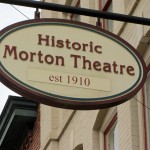On January 25, 1912, Sissieretta Jones, also known as the “Black Patti,” performed with her Black Patti Musical Comedy Company at the Morton Theatre, a black-owned theatre in downtown Athens, Georgia. The Morton Theatre, one of the few remaining black vaudeville theaters in America, was reported to be one of the first vaudeville theaters in the United States that was “built, owned, and operated by an African-American.”
Built in 1910 by businessman and former Athens postmaster Monroe Bowers (“Pink”) Morton, the Morton Theatre was in a building that housed both the theater (upstairs) as well as office and retail space, including the city’s first black-owned drugstore. The building, located at 195 West Washington Street, is at the intersection of Washington and Hull streets. That area, once the center of Athens’s black professional and commercial district, was known as the “Hot Corner.” The Theatre exists today as a rental facility for special events and a wide range of performances. Owned by Athens-Clarke County Unified Government, the theater is managed by a non-profit organization, the Morton Theatre Corporation.
Sissieretta performed there twice, once in 1912 and again on November 2, 1914, about a month before her longest running road show closed in Memphis, Tennessee. By 1912, Sissieretta had been performing with the Black Patti Troubadours, which became the Black Patti Musical Comedy Company in the summer of 1909, for sixteen years. She had become a regular visitor to Athens, first appearing there September 24, 1903, at the Opera House. Her Athens debut was front-page news in city’s newspaper, The Athens Banner.
The Troubadours performed at the white-owned Opera House in 1903, 1904, and 1905. In 1906, 1909, and 1911 the troupe appeared at the Colonial Theatre, a whites-only theater except when special performances like the Troubadours (later called the Black Patti Musical Comedy Company) prompted management to offer black patrons seats in the gallery. The Black Patti Musical Comedy Company was booked to play at the Colonial Theatre again on January 25, 1912, but a newspaper headline said the new Morton Theatre would host the company instead. The article said “special reservations and arrangements for white people” would be made. White theatergoers, and there were quite a few of them, were seated on benches in the gallery and African Americans sat on the main floor and in special theater boxes.
According to information from the Theatre’s website, the Morton family sold the building in 1973. By then, the theatre part of the building was in disrepair and no longer used. Eventually, in 1980, renewed interest in preserving the theater and the building prompted the nonprofit Morton Theatre Corporation, using state and federal funds, to buy the historic building and theatre. In 1987, Athens-Clarke County passed a special purpose local option sales tax that included $1.8 million to restore the theatre. In 1991, ownership of the building was handed over to the Athens-Clarke County Unified Government. The theatre was reopened in the fall of 1993. The building is listed on the National Register of Historic Places.
Other performers known to have appeared at the Morton include the New York Follies, Shark’s Smart Set Company and Tolliver’s Smart Set Company, Butterbeans and Susie Review, Joe Johnson’s Brown Babies and the Rags Honey Troupe. Local and regional blues performers, such as Blind Willie McTell, Curley Weaver, and Roy Dunn, also performed at the Morton. Old ticket stubs found in the theater over the years seem to suggest that famous performers like Duke Ellington, Bessie Smith, Louis Armstrong, and Cab Calloway may have graced the stage at the Morton. Unfortunately, the stubs only show the event and do not list a date or location, so it’s unknown whether these greats actually performed at the Morton.
For more information about the theater, go to www.mortontheatre.com. Additional information can be found in an article by Thomas L. Riis called, “Black Vaudeville, the TOBA, and the Morton Theatre: Recovering the History 1910-1930.”
Maureen D. Lee
November 2012

